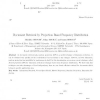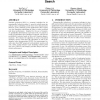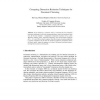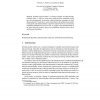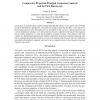Publication
This paper studies the effect of covariance regularization for classific ation of high-dimensional data. This is done by fitting a mixture of Gaussians with a regularized covaria...
IJAIT
2007
14 years 2 months ago
2007
In document retrieval task, random projection (RP) is a useful technique of dimension reduction. It can be obtained very quickly yet the recalculation is not necessary to any chang...
ICASSP
2010
IEEE
14 years 3 months ago
2010
IEEE
Random projection has been suggested as a means of dimensionality reduction, where the original data are projected onto a subspace using a random matrix. It represents a computati...
UAI
2000
14 years 4 months ago
2000
Recent theoretical work has identified random projection as a promising dimensionality reduction technique for learning mixtures of Gaussians. Here we summarize these results and ...
CIKM
2008
Springer
14 years 4 months ago
2008
Springer
Random projection (RP) is a common technique for dimensionality reduction under L2 norm for which many significant space embedding results have been demonstrated. However, many si...
SLSFS
2005
Springer
14 years 8 months ago
2005
Springer
Random projection is a simple technique that has had a number of applications in algorithm design. In the context of machine learning, it can provide insight into questions such as...
AI
2005
Springer
14 years 8 months ago
2005
Springer
In this research, a systematic study is conducted of four dimension reduction techniques for the text clustering problem, using five benchmark data sets. Of the four methods -- Ind...
BIOWIRE
2007
Springer
14 years 9 months ago
2007
Springer
Random projection (RP) is a common technique for dimensionality reduction under L2 norm for which many significant space embedding results have been demonstrated. In particular, r...
KDD
2001
ACM
15 years 3 months ago
2001
ACM
Random projections have recently emerged as a powerful method for dimensionality reduction. Theoretical results indicate that the method preserves distances quite nicely; however,...
DCC
2009
IEEE
15 years 3 months ago
2009
IEEE
An analysis is presented that extends existing Rayleigh-Ritz theory to the special case of highly eccentric distributions. Specifically, a bound on the angle between the first Rit...

